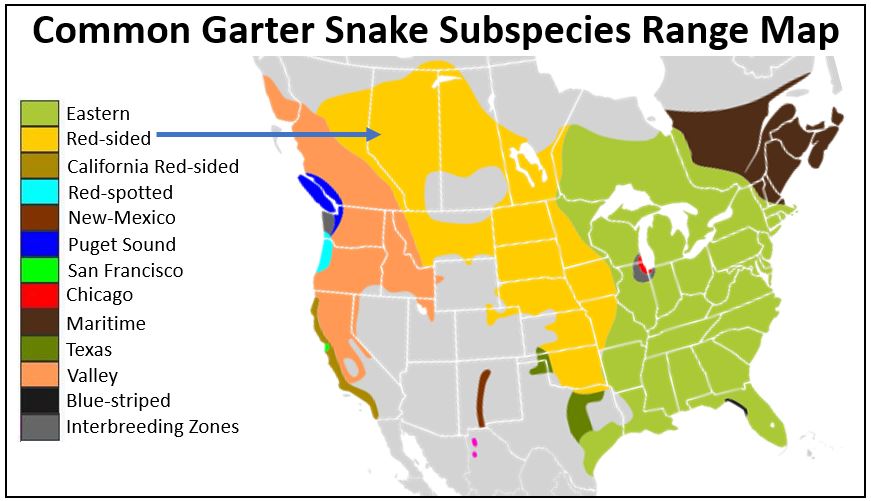4 Types of Garter Snakes in Colorado! (w/ pics)
Almost everyone can identify a “garter snake” in Colorado!

But here’s the problem:
There are multiple species and sub-species of garter snakes! Therefore, figuring out the identity of the SPECIFIC snake you are observing can be challenging. This is especially true since many of them have similar appearances and behaviors.
Today, you are going to learn about 4 garter snake species in Colorado!
- *Just a quick note – to be officially considered a garter snake, the species must be in the genus Thamnophis*
#1. Red-sided Garter Snake
- Thamnophis proximus parietalis

Identifying Characteristics:
- Normally dark green to black, but color varies.
- Three yellow stripes, one down the back and one down each side.
- As the name suggests, there are red or orange bars down their sides, located between the yellow stripes.
- Subspecies of the Common Garter Snake.
Like other garter snakes, they are habitat generalists. Look for them in many habitats in northeastern Colorado, including forests, shrublands, wetlands, fields, and rocky areas. Their favorite foods include frogs, earthworms, and leeches! YUM! 🙂

In some areas, after emerging from hibernation, there are not enough females for all the males. In these cases, “mating frenzies” occur, and dozens and dozens of these snakes can be found together.
To survive colder months, Red-sided Garter Snakes have to hibernate BELOW the frost line. Depending on the area they are located in, it can be hard to find suitable locations. So the few adequate hibernation dens can shelter hundreds, even thousands, of snakes! To see an example, watch the video below:

#2. Terrestrial Garter Snake
- Thamnophis elegans
 Identifying Characteristics:
Identifying Characteristics:
- Adults range from 18 to 41 inches in length.
- Most adults have three yellow, light orange, or white stripes; one down their back and two down their sides.
- Coloration is widely variable. Individuals may be brownish or greenish. Some have red and black spots between the stripes, and occasionally all black individuals are found.
This garter snake can be difficult to identify in Colorado!
Even trained herpetologists have issues! Its coloration varies widely, and there are believed to be 6 subspecies, although scientists still debate this.
Terrestrial Garter Snakes occupy various habitats, including both grasslands and forests. They can even be found in mountainous areas up to 13,000 feet above sea level. As the name suggests, they’re primarily found on land. But interestingly, these garter snakes can swim well!

This species is the only garter snake in Colorado with a tendency to constrict prey! Most garter snakes grab their prey quickly and just swallow, rubbing their prey against the ground if necessary.
Terrestrial Garter Snakes aren’t aggressive or dangerous, but they do possess mildly venomous saliva! It can cause a muscle infection or even kill some muscle tissue. Most bites on humans just cause pain and some swelling.
#3. Plains Garter Snake
- Thamnophis radix

Identifying Characteristics:
- Adults average 36 inches in length.
- Coloration is gray-green with a distinctive orange stripe down the back and a greenish-yellow stripe down each side.
- Distinct light yellow spots on the very top of the head!
Plains Garter Snakes are almost always found in eastern Colorado in prairies and grasslands near freshwater sources. They have a fairly large population and adapt well to human-modified landscapes, and you may spot them near abandoned buildings, trash heaps, or vacant lots.

This species is considered to be one of the most cold-tolerant of all snakes! In fact, they will even come out of hibernation on warmer winter days.

The Plains Garter Snake feeds primarily on earthworms, slugs, and small amphibians. However, they have also been observed preying on small mammals and birds, including the Eastern Meadowlark and Bank Swallow.
#4. Black-necked Garter Snake
-
Thamnophis cyrtopsis

Identifying Characteristics:
- Western Black-necked Garter Snakes are dark olive with an orange-yellow stripe down the back and a yellow to white stripe down each side. It can be up to 42 inches long.
- Eastern Black-necked Garter Snakes are smaller and only grow up to 20 inches in length. They have a checkered pattern of black and yellow on their body, in between their three stripes.
- Both subspecies have a gray head that contrasts strongly with the body. In addition, there is a dark blotch on each side of the neck.
This species is found in many habitats, including desert scrub, plains, arid grasslands, and pine-oak woodlands. They’re almost always found in Colorado in association with water sources.

There are two sub-species of this garter snake; the Western AND Eastern. They look different (see photo above), but they also behave uniquely. The Western subspecies (Thamnophis cyrtopsis cyrtopsis) are water snakes and most often found in the actual water. The Eastern (Thamnophis cyrtopsis ocellatus) subspecies prefer to live on DRY LAND that is very close to water.
The Black-necked Garter Snake’s preferred prey is frogs, toads, and their tadpoles, including poisonous species like the Sonoran Desert Toad. However, they have been known to feed on a wide range of other prey, including earthworms, skinks, salamanders, crustaceans, and birds.
Black-necked Garter Snakes adapt well to introduced species like the American Bullfrog. They have also benefited from the creation of cattle tanks since these snakes are dependent upon water.
Do you need additional help identifying garter snakes?
Try this field guide!
Which of these garter snakes have you seen in Colorado?
Leave a comment below!
-
RELATED: 20 Common SNAKES That Live in Colorado! (ID Guide)
-
RELATED: 6 Types of FROGS Found in Colorado! (w/pics)
-
VENOMOUS SNAKES that live in Colorado
-
The Complete List of WATER SNAKES found in Colorado

